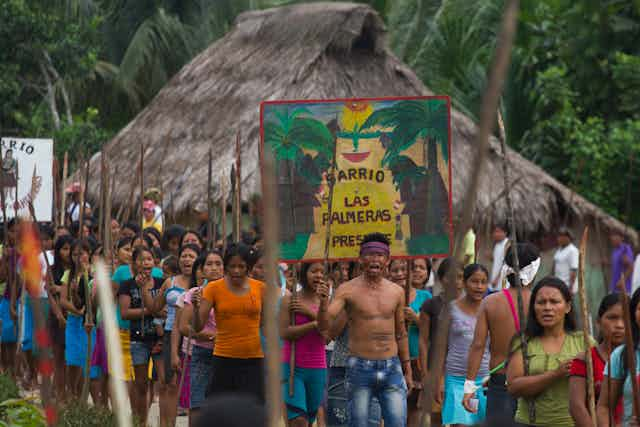Peru boasts one of the world’s fastest growing economies, largely dependent on the extraction of natural gas and oil from the Amazon, and of a long list of minerals from the Andes. Yet, this growth strategy has led to dozens of social conflicts around current and proposed extraction sites throughout the country.
Although these protests have different motivations, most activists are locals whose lives have not been significantly improved to offset the impact of gas and oil works or mining activity. These are people who have historically been allowed little say in the conversations that define their future, and that of their territories. Bagua, Conga, Las Bambas, and Pakitzpango have all become important sites of protest, local extensions of global calls to rethink our engagement with natural resources.
When Two Worlds Collide, a new documentary directed by Heidi Branderburg and Mathew Orzel, examines indigenous activism in Peru by focusing on the events that led to, and the aftermath of, the lethal clashes between indigenous protesters and policemen in 2009 outside the Amazonian town of Bagua. Although siding with the indigenous movement, Branderburg and Orzel present different voices within the debate that ensued in Peru, ranging from Garcia’s ministers to the father of a policeman that died that day.
The film’s narrative centres on Alberto Pizango, an indigenous Shawi man who served as the President of AIDESEP, Peru’s national indigenous Amazonian organisation, in the run up to the events at Bagua.
Although part of a long history of discrimination, social injustice, and dispossession between the Peruvian state and indigenous peoples, the controversy that led to Bagua originated in the introduction of special legal decrees by President Alan Garcia in 2008. These laws threatened indigenous peoples’ territorial rights, and contravened the responsibilities Peru had toward its indigenous population.

AIDESEP, representing dozens of indigenous Amazonian organisations, demanded the retraction of these decrees. Tensions rose as Garcia responded to these demands on live television by saying:
These are not first class citizens! How can 400,000 natives tell 28m Peruvians: ‘you have no right to come here?’ (…) That is their huge mistake! Those who think in those terms want to force us to irrationality and primitivism.
In response, AIDESEP called for a national strike, in which indigenous people throughout Amazonian Peru took airports and blocked motorways and rivers, thereby bringing urban centres and extraction sites to a stop. The protest outside Bagua not only brought the area to a standstill, but also threatened a nearby oil pumping station which was later taken by protesters. The controversy that resulted from the events at Bagua led to the retraction of the decrees less than a fortnight later.

Extraction and violence
When Two Worlds Collide is a good introduction to the current state of indigenous rights in Peru. As the state legally owns the resources in Peru’s subsoil, it has granted extraction concessions to multinational companies that overlap more than half of the titled indigenous territories. At present, three-quarters of Peru’s Amazon, including a fifth of protected natural areas, is zoned for extraction. These are the results of a historical process of state-led dispossession in favour of foreign capital.
The most recent consequence of the expansion of the legal and illegal extractive frontier is evident in the growing number of isolated peoples coming out of the forests due to the pressures on their territories.
As When Two Worlds Collide shows, Peru stokes the volatility of the context created by this economic agenda by dealing with anti-extraction protests as threats to national security. Protesters have become internal enemies, described by sectors of the government as green terrorists. Protests are tackled with legal responses that suspend constitutional rights within an area, acts that were passed to expedite the war against Sendero Luminoso, otherwise known as Shining Path, a Communist militant group in the country.
The leaders of these protests are being arrested and tried for crimes of rebellion and sedition, and are also pressured by legal and illegal private interests. In 2015, Global Witness reported that nine activists, including seven indigenous activists, were killed in Peru that year amid disputes over extraction sites.
As I have previously written, my indigenous Ashaninka collaborators in the Peruvian Amazon are living in a continuum of violence that links Peru’s internal war and the imposition of extractive activity in its wake. In that piece I cited an Ashaninka man who compared his fear of the Shining Path, to his fear of extractivism:
I used to be scared of the Shining Path killing my family and taking my children. But now, look at what’s happening (…) I’m scared of companies (…) of dams. Where will we go? What will we eat? Where will our children grow? We’ll just have to fight again.
When Two Worlds Collide reveals this side of Peru’s economic boom. The film sets up this context for an audience new to these issues, but also presents material to help foster an informed discussion about extraction in Peru. Branderburg and Orzel’s film is a welcome voice in the struggle to counter narratives that demonise indigenous peoples as obstacles to development. These are people whose rights have been betrayed in favour of an unsustainable economic logic and foreign interests.

